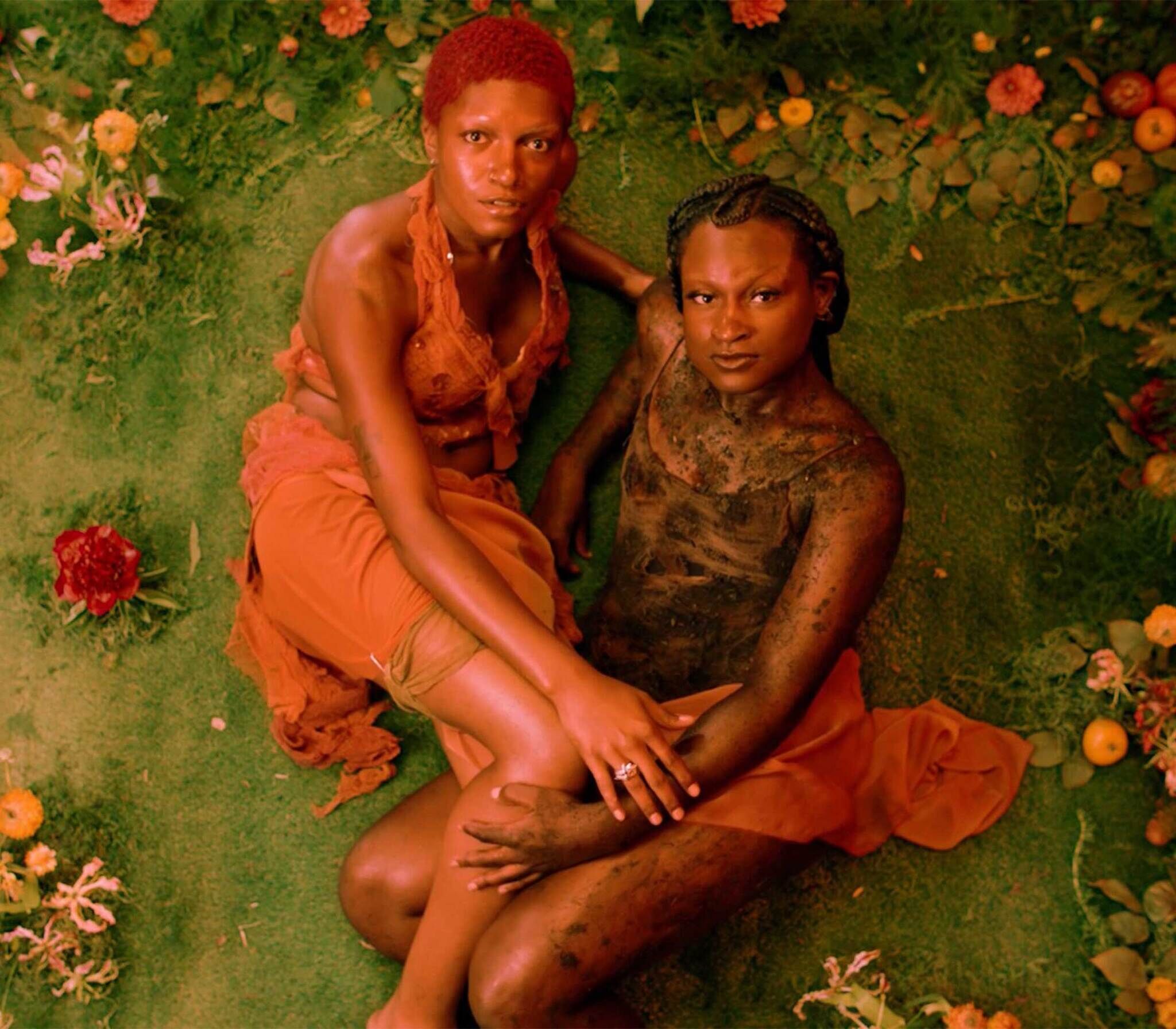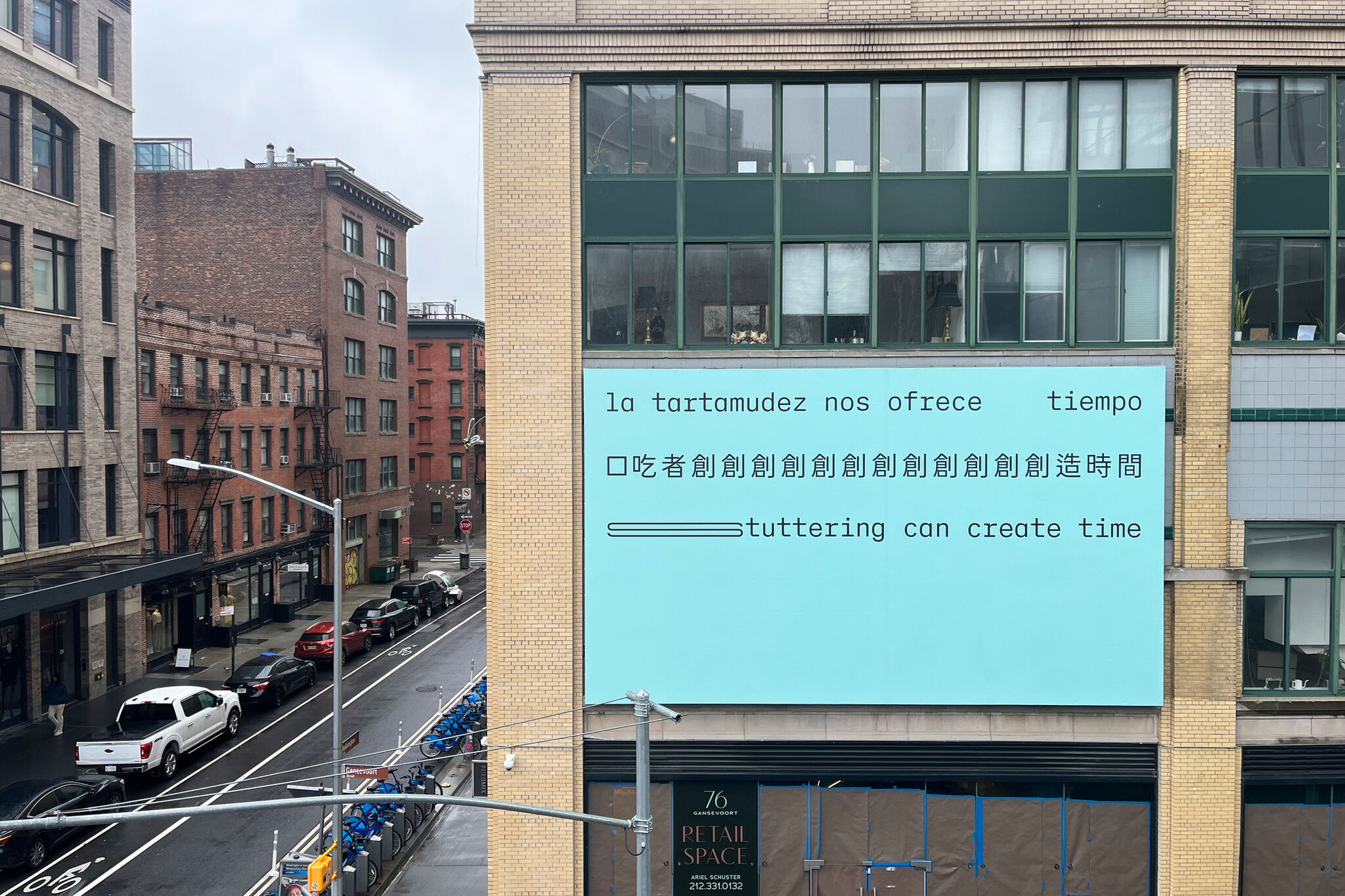Minisode: People Who Stutter Create on their 2024 Whitney Biennial Artwork
July 30, 2024
0:00
Minisode: People Who Stutter Create on their 2024 Whitney Biennial Artwork
0:00
Narrator:
Welcome to Artists Among Us Minisodes from the Whitney Museum of American Art. For us, this spring and summer are all about the 2024 Whitney Biennial. Over the course of the exhibition, we’ll be sitting down with some of the artists to talk about their work and what it means to be making art in the present moment.
Today we hear from five artists who together form the collective People Who Stutter Create. For their contribution to the 2024 Biennial, the group mobilized the Whitney’s exhibition billboard at 95 Horatio Street, across the street from the Museum and the south end of the High Line. The artists, all of whom stutter, created a public artwork that celebrates the transformational space of dysfluency, a term that can encompass stuttering and other communication differences. In this minisode, we hear from all five artists about their artwork titled Stuttering Can Create Time.
JJJJJerome Ellis:
Our group is called People Who Stutter Create and we are five people who stutter who have come together to create a billboard at the Biennial. I'm JJJJJerome Ellis and I feel so lucky that I have been able to collaborate with these these four amazing people over these past few months.
Kristel Kubart:
So my name is Kristel Kubart. I'm a speech therapist. I live in New York City and I'm a very proud person who stutters. It hasn't always been that way, I used to be very ashamed of my stuttering but helpful speech therapy and being a part of the stuttering community completely changed all of that when I heard that maybe it's okay to stutter and just have it be a part of how you speak.
Conor Foran:
My name is Conor Foran. I'm an Irish practitioner based in London and I work across art and design and a big part of that is stammering. So I kind of use art and design for stammering activism.
Delicia Daniels:
My name is Delicia Daniels and I’m in North Carolina. I would have to say that stuttering appeared for me out of the blue, so to speak, in middle school. And I had to train myself to just talk slowly because, you know, I was ashamed of it, I wasn't used to it. And so every single person on this panel, you know, gave me the opportunity to, you know, to welcome new energy and new vibes around stuttering and around scholarship connected to celebrating words that repeat.
JJJJJerome Ellis:
Hi, Jia, welcome!
Jia Bin:
Hi hi JJJJJerome! I am—compared to all the leaders in this group—I would say I am newer. I was born and grew up in China. Stuttering had always been my big biggest shame growing up. Everything I do is trying to hide hide my stuttering throughout my entire life. It's it's been a journey. I'm I'm just so so thrilled that that my my biggest shame seems to have become my biggest blessing.
Conor Foran:
So the billboard is basically three lines of text that hang from the top of the billboard and it's in Spanish, Chinese, and English. And in English it reads, “stuttering can create time.” And and the text is all black and it's on on a kind of a calm green background I would say. And in terms of the design decisions that went into it, we used my typeface, Dysfluent Mono, which emulates or represents stammering in typographic form. So the Spanish has a gap, and the Chinese repeats, and the English is stretched. So that was us kind of representing each form of stuttering essentially. So I think overall it's stammering pride coded. It doesn't say "stammering pride" but but you can definitely get that from the billboard. And yeah, just on the color as well—we wanted to add some kind of color. By adding this green—the color green has been used by the stammering community for years and years and years as a point of representation—we thought that maybe that would be the most appropriate. And it gave the billboard a bit more color and a bit more warmth and a bit more vibrancy.
Kristel Kubart:
I know people will listen to this who don't know that much about stuttering. So repetition is when the first couple of sounds repeat like, just like that. Prolongation is when the sound gets stretched like that. And a block is when a person experiences a lot of tension and just no sound is coming out. So those are the three types of stuttering that we represented on the billboard. And then in those moments, sometimes people who stutter have to make a choice, you know. Are they going to let the stuttering out? Are they afraid to stutter in that moment? And they might try to switch words or, you know, pretend they forgot what they were going to say. So that's why this idea of stuttering pride can be so powerful—you're actually saying what you want to say even if it comes out, you know, repeated or long like that.
Conor Foran:
And also I forgot actually to say that the bottom half of the billboard is completely empty, which some people might be wondering why we did that, because it's like, we’ve been given this really huge space, but our statement only takes up a bit of it. But we did that intentionally because it does play with this idea of pauses and hesitations and expectations.
Delicia Daniels:
Working in a public space I think is important and essential because a lot of times people who stutter feel unseen and unheard. And I feel like this platform, you know, raises the volume for people who, you know, tend to, you know—I used to sit in the back, and I'm quiet, don't say much, and be very brief. You know, as I feel something coming on, I'll stop.
Jia Bin:
This is something new but at the same time the power I think the power of of the the visuals and the power of art will trigger some discomfort, maybe, in the people who stutter who are still on the journey of moving towards acceptance and maybe the public would say, “Why?! You know, this is the worst thing to be put out there.” So I feel like this is a very loud way, even through the silent words, to put the message out.
JJJJJerome Ellis:
I'm I'm moved by the way that that that that that that all of y'all throughout the process have have had such such care careful attention to the weight of each word. As as as you're saying, Delicia and Jia, about the volume. And it has personally helped me think about this experience that that many people who stutter have on a daily basis—feeling like they are wasting time or taking up too much time or not communicating in the amount of time that is allowed, you know.
Jia Bin:
So when we were doing our discussion, we also mentioned how it takes two to stutter from the listener’s perspective. Like stuttering creates time not just for the people who stutter perspectives, but from the listener’s perspective too. We we open the space, we we create time for the listeners, invite them to our communication styles, invite them to become better listeners—deeper listeners—to build this human connection through a unique way of communicating.
Kristel Kubart:
Personally, I'm just so excited about the fact that there's going to be a stuttering billboard. It warms the heart to know that it will be seen, that it will challenge people’s ideas about stuttering because stuttering is something that is still very stigmatized and not very well understood. And I think the billboard kind of poses a new way of looking at stuttering and it's going to create a lot of conversations about stuttering in places that normally wouldn't exist.
JJJJJerome Ellis:
I'm glad. Yeah, I'm I'm I'm glad that that that it all feels good for everybody and I and I could not be more, just more grateful and lucky to, you know, just to be a part of this this group of amazing people.
JJJJJerome Ellis:
I just wanted to also honor the work and creativity of Zoe (Yu) Cui who helped us as the typography consultant.
Jia Bin:
Oh, I do want to add one more name—Angelica Bernabe. She she helped us with with with the Spanish translation as well.
Narrator:
Artists Among Us Minisodes are produced at the Whitney Museum of American Art by Anne Byrd, Nora Gomez-Strauss, Kyla Mathis-Angress, Sascha Peterfreund, Emma Quaytman, and Emily Stoller-Patterson.
Today we hear from five artists who together form the collective People Who Stutter Create. For their contribution to the 2024 Biennial, the group mobilized the Whitney’s exhibition billboard at 95 Horatio Street, across the street from the Museum and the south end of the High Line. The artists, all of whom stutter, created a public artwork that celebrates the transformational space of dysfluency, a term that can encompass stuttering and other communication differences. In this minisode, we hear from all five artists about their artwork titled Stuttering Can Create Time.


